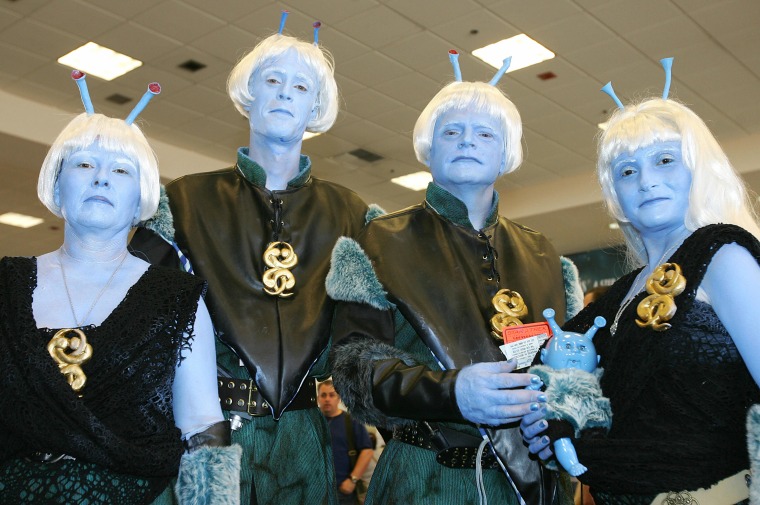It seems like the TV show that never dies.
Forty years ago a science fiction show debuted on television with a paltry budget and a bold mission to go where no one had gone before.
That show, of course, was Star Trek, which sent Captain James T. Kirk (played by the now iconic William Shatner) and his Starship Enterprise crew on a voyage to a final frontier. Created by Gene Roddenberry and billed as a ‘Wagon Train to the Stars,’ Star Trek debuted on Sept. 8, 1966 on a five-year mission that is as entrenched in the American lexicon as apple pie and baseball (both of which have popped up in episodes at one time or another, in fact).
“It’s so American because in America we integrate people into one,” says NASA astronaut and Trek fan Mike Fincke of the show, adding that Roddenberry’s concept of people rising above their differences to explore space can be seen in the International Space Station (ISS). “Gene Roddenberry had a nice vision that I think we, on the space station, are encapsulating. Did he create that environment?...There’s all kinds of fun arguments that people can make.”
Exploration aside, was it Kirk’s endless womanizing and torn-shirt bravado that cemented the show’s cult status when it went into syndication? Or was it unending bickering between Spock (Leonard Nimoy) and Dr. Leonard “Bones” McCoy (DeForest Kelley), and the tough themes the crew dealt with?
Maybe Star Trek was a sign of changing times. The show aired the first interracial kiss – between Kirk and Uhura (Nichelle Nichols) in Plato’s Stepchildren – and uttered the first televised “Hell” – from Kirk in The City on the Edge of Forever. While groundbreaking in the 1960s, such things seem tame given what’s on the tube today.
“They’ve always managed to be topical, all the way from race relations in the 1960s to the end of the Cold War (Star Trek VI: The Undiscovered Country),” says Fincke, who spoke to actor Scott Bakula – the latest Starship Enterprise captain Jonathan Archer – from orbit during his Expedition 9 mission to the ISS in 2004. “It serves as a parable for human behavior by taking subjects in a fantastic sense so we can discuss it close to home.”
Star Trek’s final original series episode aired in June 1969. One month later, NASA’s Apollo 11 astronauts Neil Armstrong and Buzz Aldrin landed on the Moon while their fellow crewmate Michael Collins remained in lunar orbit.
After four decades of Star Trek, the show’s legacy has spawned ten feature films –soon to be eleven – and sired no less than four spin-off television series and an animated show. And let’s not forget the countless convention, novels, comic books, models and other merchandise that still feed rabid fans even after the last series – Star Trek: Enterprise – was canceled in 2005. The demise of Enterprise, due to dismal ratings that no write-in campaign could spare, ended 18 years of continuous Trek TV since 1987 premiere of The Next Generation.
But the effect of Star Trek has reached beyond science fiction and into science fact.
NASA’s first space shuttle, a prototype for landing tests, was named Enterprise in honor of the legendary starship after a massive fan campaign flooded the White House with letters. The orbiter made its first flights in February 1977. Roddenberry himself reached space after death when his ashes were launched aboard NASA’s Columbia orbiter in 1992.
British entrepreneur Sir Richard Branson has even named the first suborbital vehicle in his Virgin Galactic spaceliner fleet to carry paying thrill-seekers to the edge of space the VSS Enterprise, though it has yet to fly.
During its lifetime, Star Trek featured many real-life astronauts like Fincke – who appeared in Enterprise’s final episode with fellow astronaut Terry Virts – on its various series. The experience, Fincke says, was both exhilarating and eye-opening.
“You sit there on the bridge and you say ‘Wow, this is the bridge of a starship,’ and you actually look and it’s all smoke and mirrors,” Fincke says. “The buttons don’t really work. Any spacecraft I’m on, the shuttle, Soyuz, the International Space Station, you don’t really want to touch buttons unless you know how they work.”
But despite Enterprise’s end, Star Trek is undergoing a resurgence of sorts. The cable channel G4TV refitted the original series into Star Trek 2.0, where viewers add live commentary, catch episode trivia in real-time and trade character stock on the Spock Market. Meanwhile, director J.J. Abrams, creator of TV’s Lost and Alias, is drawing up plans for the eleventh Trek film – rumored to be a prequel to the original series – and the Christie’s auction house in New York will host a memorabilia bonanza in October for the show’s 40th anniversary.
“Star Trek won’t die because there is that interest,” Fincke says. “It touches a fundamental nerve in human beings, especially Americans, because we’re pioneers and explorers…all these things that are the good parts of our country, and Star Trek captures that in a glorious way and gives us a picture towards the future.”
